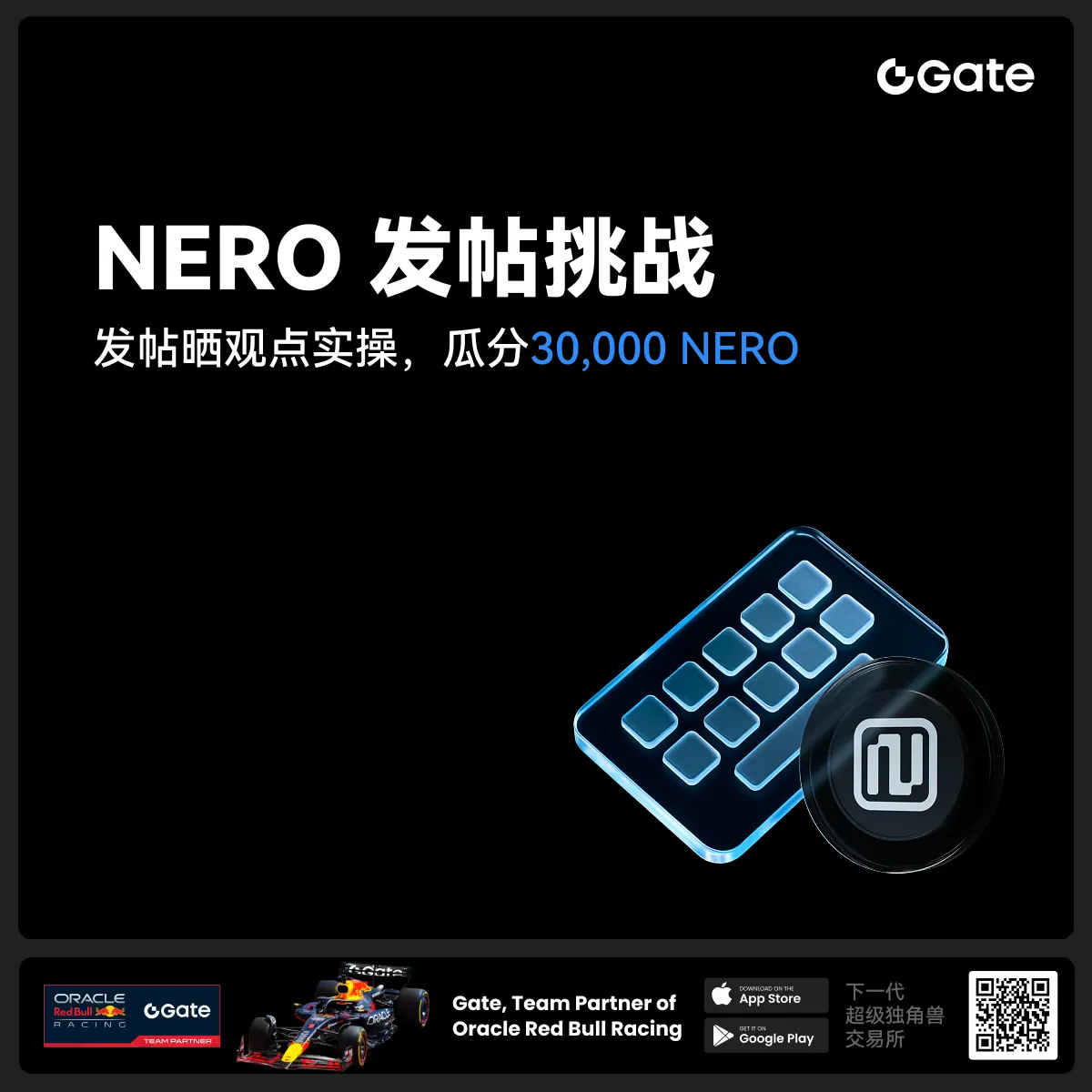- 话题1/3
56551 热度
39815 热度
54974 热度
8436 热度
22910 热度
- 置顶
- 🎉 #CandyDrop合约挑战# 正式开启!参与即可瓜分 6 BTC 豪华奖池!
📢 在 Gate 广场带话题发布你的合约体验
🎁 优质贴文用户瓜分$500 合约体验金券,20位名额等你上榜!
📅 活动时间:2025 年 8 月 1 日 15:00 - 8 月 15 日 19:00 (UTC+8)
👉 活动链接:https://www.gate.com/candy-drop/detail/BTC-98
敢合约,敢盈利
- 🎉 攒成长值,抽华为Mate三折叠!广场第 1️⃣ 2️⃣ 期夏季成长值抽奖大狂欢开启!
总奖池超 $10,000+,华为Mate三折叠手机、F1红牛赛车模型、Gate限量周边、热门代币等你来抽!
立即抽奖 👉 https://www.gate.com/activities/pointprize?now_period=12
如何快速赚成长值?
1️⃣ 进入【广场】,点击头像旁标识进入【社区中心】
2️⃣ 完成发帖、评论、点赞、发言等日常任务,成长值拿不停
100%有奖,抽到赚到,大奖等你抱走,赶紧试试手气!
截止于 8月9日 24:00 (UTC+8)
详情: https://www.gate.com/announcements/article/46384
#成长值抽奖12期开启#
- 📢 Gate广场 #NERO发帖挑战# 秀观点赢大奖活动火热开启!
Gate NERO生态周来袭!发帖秀出NERO项目洞察和活动实用攻略,瓜分30,000NERO!
💰️ 15位优质发帖用户 * 2,000枚NERO每人
如何参与:
1️⃣ 调研NERO项目
对NERO的基本面、社区治理、发展目标、代币经济模型等方面进行研究,分享你对项目的深度研究。
2️⃣ 参与并分享真实体验
参与NERO生态周相关活动,并晒出你的参与截图、收益图或实用教程。可以是收益展示、简明易懂的新手攻略、小窍门,也可以是行情点位分析,内容详实优先。
3️⃣ 鼓励带新互动
如果你的帖子吸引到他人参与活动,或者有好友评论“已参与/已交易”,将大幅提升你的获奖概率!
NERO热门活动(帖文需附以下活动链接):
NERO Chain (NERO) 生态周:Gate 已上线 NERO 现货交易,为回馈平台用户,HODLer Airdrop、Launchpool、CandyDrop、余币宝已上线 NERO,邀您体验。参与攻略见公告:https://www.gate.com/announcements/article/46284
高质量帖子Tips:
教程越详细、图片越直观、互动量越高,获奖几率越大!
市场见解独到、真实参与经历、有带新互动者,评选将优先考虑。
帖子需原创,字数不少于250字,且需获得至少3条有效互动
- 🎉 亲爱的广场小伙伴们,福利不停,精彩不断!目前广场上这些热门发帖赢奖活动火热进行中,发帖越多,奖励越多,快来GET你的专属好礼吧!🚀
1️⃣ #GateLaunchpad上线IKA# |IKA认购体验
在Gate广场带话题晒出你的IKA Launchpad认购体验,4位幸运分享者讲瓜分$200分享奖池!
详情 👉️ https://www.gate.com/post/status/12566958
2️⃣ #ETH冲击4800# |行情分析预测
大胆发帖预测ETH走势,展示你的市场洞察力!10位幸运用户将平分0.1 ETH 奖励!
详情 👉️ https://www.gate.com/post/status/12322403
3️⃣ #创作者活动第二期# |ZKWASM话题
在广场或推特发布与 ZKWASM 或其交易活动相关的原创内容,瓜分4,000枚ZKWASM!
详情 👉️ https://www.gate.com/post/status/12525794
4️⃣ #Gate广场征文活动第二期# |ERA话题
谈谈你对ERA的观点/体验,参与并推广活动,700 ERA大奖等你赢!
详情 👉️ https://www.gate.com/post/status/12361653
5️⃣ #MBG任务挑战# |MBG话题
分享你对MBG的洞察,积极参与和推广MBG活动,20位小 - 🎉Gate 2025 上半年社区盛典:内容达人评选投票火热进行中 🎉
🏆 谁将成为前十位 #Gate广场# 内容达人?
投票现已开启,选出你的心头好
🎁赢取 iPhone 16 Pro Max、限量周边等好礼!
📅投票截止:8 月 15 日 10:00(UTC+8)
立即投票: https://www.gate.com/activities/community-vote
活动详情: https://www.gate.com/announcements/article/45974
DePIN机器人技术的挑战与机遇:迈向去中心化智能新纪元
DePIN与具身智能的融合:挑战与前景
随着人工智能技术的快速发展,去中心化物理基础设施网络(DePIN)在机器人领域的应用引发了广泛关注。近期,一场关于"构建去中心化物理人工智能"的讨论深入探讨了DePIN在机器人技术领域面临的挑战和机遇。尽管这一领域仍处于起步阶段,但其潜力巨大,有望彻底改变AI机器人在现实世界中的运作方式。
然而,与传统依赖大量互联网数据的AI不同,DePIN机器人AI技术面临更为复杂的问题,包括数据收集、硬件限制、评估瓶颈以及经济模式的可持续性等。本文将深入分析DePIN机器人技术所面临的主要障碍,探讨为何DePIN比中心化方法更具优势,并展望DePIN机器人技术的未来发展趋势。
DePIN智能机器人的主要瓶颈
1. 数据收集与质量
与依赖大量互联网数据的传统AI大模型不同,具身化AI需要与现实世界进行直接互动才能发展智能。然而,目前缺乏大规模的基础设施来收集这类数据,且业界对如何有效收集这些数据尚无共识。具身化AI的数据收集主要分为三类:
2. 自主性水平
机器人技术要实现商业化应用,成功率需要接近99.99%甚至更高。然而,每提高0.001%的准确率都需要付出指数级的时间和精力。机器人技术的进步不是线性的,而是指数性质的,每前进一步,难度都会大幅增加。
3. 硬件限制
即使AI模型再先进,现有的机器人硬件也未能完全支持真正的自主性。主要问题包括:
4. 硬件扩展难度
智能机器人技术的实现需要在现实世界中部署物理设备,这带来了巨大的资本挑战。目前,只有财力雄厚的大公司才能负担得起大规模实验。即使是最高效的仿人机器人,成本也高达数万美元,难以实现大规模普及。
5. 评估有效性
评估物理AI需要在现实世界中长期、大规模部署,这一过程耗时且复杂。与可以迅速评估的线上AI大模型不同,机器人AI的性能评估需要大量时间和资源。
6. 人力资源需求
机器人AI开发中,人类劳动力仍然不可或缺。需要人类操作员提供训练数据、维护团队保持机器人运行,以及研究人员持续优化AI模型。这种持续的人类干预是DePIN必须解决的一个主要挑战。
未来展望:机器人技术的突破性时刻
尽管通用机器人AI距离大规模采用还有一段距离,但DePIN机器人技术的进展让人看到了希望。去中心化网络的规模和协调性能够分散资本负担,加速数据收集和评估过程。
数据收集和评估加速:去中心化网络可以并行运行、收集数据,大幅提高效率。
AI驱动的硬件设计改进:利用AI优化芯片和材料工程,可能会显著缩短开发周期。
新型盈利模式:去中心化机器人技术网络展示了新的盈利可能,如自主运行的AI代理通过代币激励维持自身财务。
开放协作:DePIN机器人网络的建立意味着机器人数据收集、计算资源和资本投入可以在全球范围内协同进行,降低开发门槛,让更多参与者加入。
总之,机器人AI的发展不仅依赖算法,还涉及硬件升级、数据积累、资金支持以及人的参与。DePIN机器人网络的建立有望打破传统机器人行业的局限,创造一个更加开放、可持续的技术生态系统。随着全球社区的共同推动,我们期待看到机器人技术迎来真正的突破性时刻。